Atlas / 17 / college freshman / big dumb / writing major / chaotic good
Don't wanna be here? Send us removal request.
Text
all the tips I found for drawing a fantasy map are like :) “here’s a strategy to draw the land masses! here’s how to plot islands!” :) and that’s wonderful and I love them all but ??? how? do y'all decide where to put cities/mountains/forests/towns I have my map and my land but I’m throwing darts to decide where the Main Citadel where the Action Takes Place is
97K notes
·
View notes
Text
youtube channels to motivate you this semester
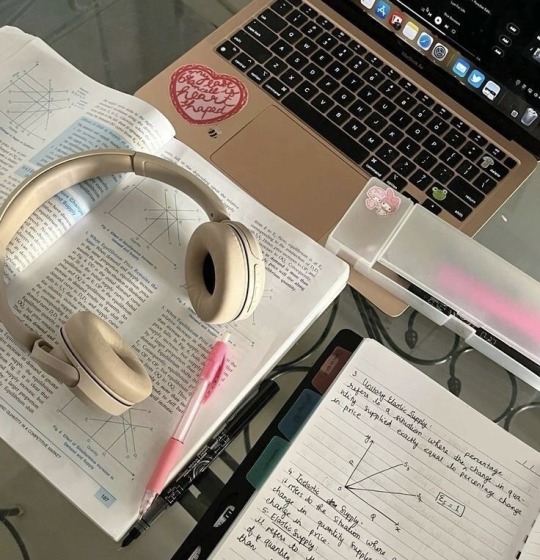

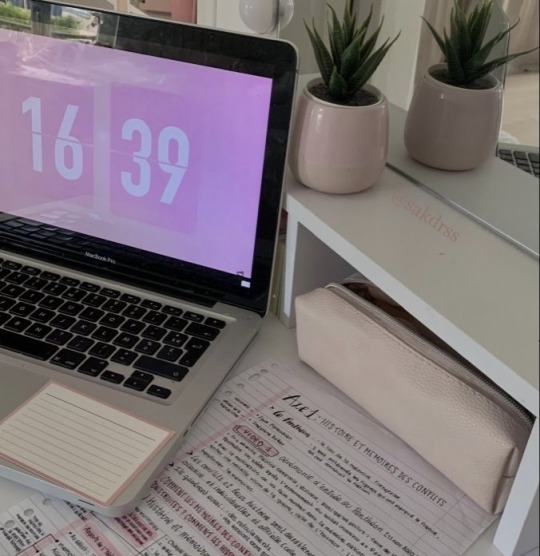
♡ abao in tokyo - study with me’s & playlists
♡ advika singh - study & productivity vlogs
♡ allie c. - medical school vlogs
♡ carrot td - study with me’s
♡ celine - study with me’s
♡ deaana - medical school, study with me’s, stationary, etc.
♡ dear mimi - study vlogs
♡ dia - medical student vlogs
♡ dr. rachel southard, do - medical school & residency vlogs & talks
♡ emily feng - medical school vlogs
♡ emilystudying - dental school & study vlogs
♡ emma grace - nursing school vlogs
♡ emmalilyn - study with me’s
♡ ginny - study vlogs
♡ hyobin - medical student vlogs
♡ leighton sanders - nursing vlogs
♡ lucky penny - study with me’s
♡ lunardazes. - uni study vlogs
♡ madi’s nursing journey - nursing school & nursing vlogs
♡ mango oatmilk - study with me’s
♡ maria silva - study & hospital interning vlogs
♡ merve - study with me’s
♡ mishujo - study & productive vlogs
♡ nada - study & productivity vlogs
♡ ray hon - study with me’s
♡ sab yang - medical school & study vlogs
♡ sean study - study with me’s
♡ sierra lyn - nursing vlogs
♡ studymd - study with me’s
♡ study to success - stationary, study with me’s, study hacks, etc.
♡ tani study - study with me’s
♡ yours truly, chloe - study vlogs
♡ yulma - study with me’s
14K notes
·
View notes
Text
HOW TO GIVE PERSONALITY TO A CHARACTER
Giving personality to a character is an essential part of character development in storytelling, whether you're writing a novel, screenplay, or creating a character for a role-playing game. Here are some steps and considerations to help you give personality to your character:
Understand Their Backstory:
Start by creating a detailed backstory for your character. Where were they born? What were their childhood experiences like? What significant events have shaped their life? Understanding their past can help you determine their motivations, fears, and desires.
2. Define Their Goals and Motivations:
Characters often become more interesting when they have clear goals and motivations. What does your character want? It could be something tangible like a job or a romantic relationship, or it could be an abstract desire like happiness or freedom.
3. Determine Their Strengths and Weaknesses:
No one is perfect, and characters should reflect this. Identify your character's strengths and weaknesses. This can include physical abilities, intellectual skills, and personality traits. Flaws can make characters relatable and three-dimensional.
4. Consider Their Personality Traits:
Think about your character's personality traits. Are they introverted or extroverted? Shy or outgoing? Kind or selfish? Create a list of traits that describe their character. You can use personality frameworks like the Myers-Briggs Type Indicator or the Big Five Personality Traits as a starting point.
5. Give Them Quirks and Habits:
Quirks and habits can make a character memorable. Do they have a specific way of speaking, a unique fashion style, or an unusual hobby? These details can help bring your character to life.
6. Explore Their Relationships:
Characters don't exist in isolation. Consider how your character interacts with others. What are their relationships like with family, friends, and enemies? These relationships can reveal a lot about their personality.
7. Show, Don't Tell:
Instead of explicitly telling the audience about your character's personality, show it through their actions, dialogue, and decisions. Let the reader or viewer infer their traits based on their behavior.
8. Create Internal Conflict:
Characters with internal conflicts are often more engaging. What inner struggles does your character face? These can be related to their goals, values, or past experiences.
9. Use Character Arcs:
Consider how your character will change or grow throughout the story. Character development is often about how a character evolves in response to the events and challenges they face.
10. Seek Inspiration:
Draw inspiration from real people, other fictional characters, or even historical figures. Study how people with similar traits and backgrounds behave to inform your character's actions and reactions.
11. Write Dialogue and Inner Monologues:
Writing dialogue and inner monologues from your character's perspective can help you get inside their head and understand their thought processes and emotions.
12. Consider the Setting:
The setting of your story can influence your character's personality. For example, a character who grows up in a war-torn environment may have a different personality than one raised in a peaceful, affluent society.
13. Revise and Refine:
Don't be afraid to revise and refine your character as you write and develop your story. Characters can evolve and change as the narrative unfolds.
Remember that well-developed characters are dynamic and multi-faceted. They should feel like real people with strengths, weaknesses, and complexities. As you write and develop your character, put yourself in their shoes and think about how they would react to various situations. This will help you create a compelling and believable personality for your character.
13K notes
·
View notes
Text
Some of My Favorite Ways to Describe a Character Who’s Sick
pressing their forehead into something cool or comfortable (this could be an array of things. the table, the floor, someones leather jacket, their water bottle, the countertop)
warm to the touch, or heat radiating from them (could be noticed if someone’s gauging their temperature with their hands, hugging them, or just generally touching them)
leaning into people’s touch, or just spontaneously leaning on them (like pressing into their hand when someone’s checking their temp, or just, like, literally walking up and laying their head on them from fatigue. bonus points if the character is usually feral and the other is scared to engage™︎)
falling asleep all over the place (at the dinner table, on their homework, in the car, in the bathroom — just being so exhausted from doing literally nothing)
being overly emotional (crying over things that don’t usually bother them, like their siblings arguing, or their homework, or literally just nothing)
stumbling/careening/staggering into things (the wall, furniture, other people. there is no coordination in feverish brains. running into chairs, hitting the door, falling over the couch, anything and everything)
slurring their words (could be from fatigue or pain. connecting words that shouldn’t be connected, murdering all of their conversations with the excessive use of ‘mm’ and ‘nn’ in place of words) (this is my favorite thing ever)
being overly touchy (basically like a sick kid — just hold them, please. do that thing where you brush their hair back out of their face, or rub circles on their back, or snuggle them. they won’t care. bonus points if this is also the feral character and they refuse to believe it afterwards)
being extremely resistant to touch (flinching away when they usually don’t so someone can’t feel the fever, not letting themselves be touched because they’re so tired they just know they’ll be putty in their hands if they do)
growing aggressive or being extremely rude (it’s a defense mechanism — they feel vulnerable and are afraid of being manipulated or deceived while they’re ill)
whimpering/whining/groaning (this was in my “characters in pain” post but it’s so good that i’m putting it here too. this shite is gold, especially if it’s just an involuntary reaction to their symptoms)
having nightmares caused by a fever and/or delirium (crying and murmuring in their sleep, or being awake but completely out of it and convinced they’re somewhere else)
making themselves as small as possible (curling up into a ball everywhere they lay, hunching over slightly when standing, wrapping their arms around themselves)
TW for vomiting below cut !!
sleeping in the bathroom floor because they keep getting sick over and over (bonus if someone finds them all weak and pitiful. bonus bonus if they find them there in the morning only to learn they’ve been there all night)
using their hands/other body parts to clamp over their mouth so nothing can come out (like pulling their knees up to their chest and using that, or like, their arm, y’know) (~maccreadysbaby who has emetophobia suddenly gets very awkward about this post~) (~yes i have a phobia of puke and still write this happening to my characters, shut up~) (~it’s about the hurt/comfort okay~)
sympathy pukers (people who aren’t the sick ones but get nauseous/vomit when they see someone else throw up) (~aka me~) (~okay I’m done now~)
dry heaving (it’s gross, but good for making your characters absolutely freaking miserable)
rolling/churning/spinning/cramping/ lurching and all those awesome words that describe what stomachs do when sick (i hate these words with a deep, fiery passion. but they’re good for writing or whatever)
17K notes
·
View notes
Text
20 Emotional Wounds in Fiction That Make Readers Root for the Character
Abandonment: Characters who have been abandoned by loved ones or caregivers can evoke sympathy from readers.
Betrayal: Being betrayed by someone close can create deep emotional wounds that make readers empathize with the character.
Loss of a Loved One: Whether through death or separation, the loss of a loved one can be a powerful emotional wound.
Rejection: Characters who experience rejection, whether in relationships or by society, can be relatable and evoke empathy.
Abuse: Physical, emotional, or psychological abuse can create complex wounds that shape a character's personality and behavior.
Neglect: Characters who have been neglected, especially in childhood, can evoke sympathy from readers.
Failure: Experiencing a significant failure or loss can create emotional wounds that make characters more relatable.
Guilt: Characters who carry guilt for past actions or decisions can be compelling and evoke empathy from readers.
Shame: Feelings of shame can create internal conflict and make characters more relatable and sympathetic.
Injustice: Characters who have experienced injustice or unfair treatment can evoke strong emotions from readers.
Trauma: Characters who have experienced traumatic events, such as war or natural disasters, can be sympathetic and relatable.
Loneliness: Characters who feel lonely or isolated can evoke empathy from readers who have experienced similar feelings.
Fear: Characters who face their fears or struggle with phobias can be relatable and evoke empathy from readers.
Self-doubt: Characters who struggle with self-doubt or low self-esteem can be relatable and evoke sympathy.
Identity Crisis: Characters who are grappling with questions of identity or struggling to find their place in the world can be sympathetic.
Addiction: Characters who struggle with addiction can be complex and evoke empathy from readers.
Betrayal of Trust: Characters who have had their trust betrayed can be sympathetic and relatable.
Unrequited Love: Characters who experience unrequited love can be sympathetic and evoke empathy from readers.
Isolation: Characters who feel isolated or disconnected from others can be relatable and evoke sympathy.
Fear of Failure: Characters who struggle with a fear of failure can be relatable and evoke empathy from readers.
11K notes
·
View notes
Text
how to write creepy stories
over describe things
under describe things
short sentences in rapid succession build tension
single sentence paragraphs build dread
uncanny valley = things that aren't normal almost getting it right
third person limited view
limited expressions
rot, mold, damage, age, static, flickering, espsecially in places it shouldn't be
limited sights for your mc - blindness, darkness, fog
being alone - the more people there are, the less scary it is
intimate knowledge, but only on one side
your reader's imagination will scare them more than anything you could ever write. you don't have to offer a perfectly concrete explanation for everything at the end. in fact, doing so may detract from your story.
11K notes
·
View notes
Text
Hey! Are there blacksmiths in your story? I'm a hobbyist blacksmith and I'm here to help!
Blacksmithing is one of those things that a lot of people get wrong because they don't realize it stuck around past the advent of the assembly line. Here's a list of some common misconceptions I see and what to do instead!
Not all blacksmiths are gigantic terrifying muscly guys with beards and deep voices. I am 5'8, skinny as a twig, have the muscle mass of wet bread, and exist on Tumblr. Anybody who is strong enough to pick up a hammer and understands fire safety can be a blacksmith.
You can make more than just swords with blacksmithing. Though swords are undeniably practical, they're not the only things that can be made. I've made candle holders, wall hooks, kebab skewers, fire pokers, and more. Look up things other people have made, it's really amazing what can be done.
"Red-hot" is actually not that hot by blacksmith terms. when heated up, the metal goes from black, to red, to orange, to yellow, to white. (for temperature reference, I got a second degree burn from picking up a piece of metal on black heat) The ideal color to work with the metal is yellow. White is not ideal at all, because the metal starts sparking and gets all weird and lumpy when it cools. (At no point in this process does the metal get even close to melting. It gets soft enough to work with, but I have never once seen metal become a liquid.)
Blacksmithing takes fucking forever. Not even taking into account starting the forge, selecting and preparing metal, etc. etc. it takes me around an hour to make one (1) fancy skewer. The metals blacksmiths work with heat up and cool down incredibly fast. When the forge is going good, it only takes like 20 seconds to get your metal hot enough to work with, but it takes about the same time for it to cool down, sometimes even less.
As long as you are careful, it is actually stupidly easy to not get hurt while blacksmithing. When I picked up this hobby I was like "okay, cool! I'm gonna make stuff, and I'm gonna end up in the hospital at some point!" Thus far, the latter has yet to occur. I've been doing this for nearly a year. I have earned myself a new scar from the aforementioned second degree burn, and one singe mark on my jeans. I don't even wear gloves half the time. Literally just eye protection, common sense, and fast reflexes and you'll probably be fine. (Accidents still happen of course, but I have found adequate safety weirdly easy to achieve with this hobby)
A forge is not a fire. The forge is the thing blacksmiths put their metal in to heat it up. It starts as a small fire, usually with newspaper or something else that's relatively small and burns easily, which we then put in the forge itself, which is sort of a fireplace-esque thing (there's a lot of different types of forge, look into it and try to figure out what sort of forge would make the most sense for the context you're writing about) and we cover it with coal, which then catches fire and heats up. The forge gets really hot, and sometimes really bright. Sometimes when I stare at the forge for too long it's like staring into the sun. The forge is also not a waterfall of lava, Steven Universe. It doesn't work like that, Steven Universe.
Welding and blacksmithing are not the same thing. They often go hand-in-hand, but you cannot connected two pieces of metal with traditional blacksmithing alone. There is something called forge welding, where you heat your metal, sprinkle borax (or the in-universe equivalent) on it to prevent the metal from oxidizing/being non-weldable, and hammer the pieces together very quickly. Forge welding also sends sparks flying everywhere, and if you're working in a small space with other blacksmiths, you usually want to announce that you're welding before you do, so that everyone in a five-foot radius can get out of that five-foot radius. You also cannot just stuck some random pebbles into the forge and get a decent piece of metal that you can actually make something with, Steven Universe. It doesn't work like that, Steven Universe.
Anvils are really fucking heavy. Nothing else to add here.
Making jewelry is not a blacksmithing thing unless you want jewelry made of steel. And it will be very ugly if you try. Blacksmithing wasn't invented to make small things.
If there's anything here I didn't mention, just ask and I'll do my best to answer.
38K notes
·
View notes
Text
Questions I Ask My Beta Readers
"Did you like it?" just doesn't cut it when you're trying to get useful feedback, so here's some questions that get your reader really thinking about your work:
What are your general impressions after reading? How did you feel when the book ended?
(For fantasy/sci-fi) What did you find most confusing about the world? What did you find the most interesting? What do you want to know more about?
Were there any scenes that broke your suspension of disbelief? Which ones? Why?
Which chapters were the hardest to get through? Did you find yourself skimming the text at any point in the story?
Which character was your favorite? Which was your least favorite? Why? (Note that this question is best when asking multiple readers. If one person really dislikes a character, it could be personal preference. If multiple people can't stand a character for the same reason.... well, that's a problem you need to fix. Unless, of course, you want your readers to hate that character. Just make sure that their hatred enhances the reading experience instead of ruining it).
Did you get any characters confused or mixed up? If so, did this make the story hard to follow?
What was the most suspenseful moment in the book? What was your favorite moment of the story? What was your least favorite moment in the story? Why?
Which setting in the book was clearest to you as you were reading it? Which setting was the most difficult to envision?
Did you feel there was a lot of info dumping at any point? If so, where?
How do you feel about the plot? Were there any parts that confused you or seemed nonsensical/ illogical?
Did you feel any part of the story was predictable? Do you have any predictions for the next book(s)? If so, what are they? (Again, another question that's best when asking multiple readers. Be aware of your audience here. Some people, especially those who read a lot, are really good at predicting where stories are going to go. If those people are able to guess what happens next, that might actually be a good thing, because it could indicate that your story is progressing logically. Too much predictability is a problem, but a little isn't bad. This question is just to make sure the plot twists/progression aren't painfully obvious to most readers).
What plot holes did you find in the story so far?
Were you invested in the story? If so, at what point did you become invested? Did you lose this interest at any point? (The second point here is really good for determining whether you have a slow beginning. Sometimes readers might really like your story overall, but would not have gotten past the first few chapters if they were reading it for fun instead of as a favor for you. This happened to me last time I asked someone to read my work, and it made it clear how much of the beginning I needed to rewrite entirely).
Any other questions or comments?
3K notes
·
View notes
Text
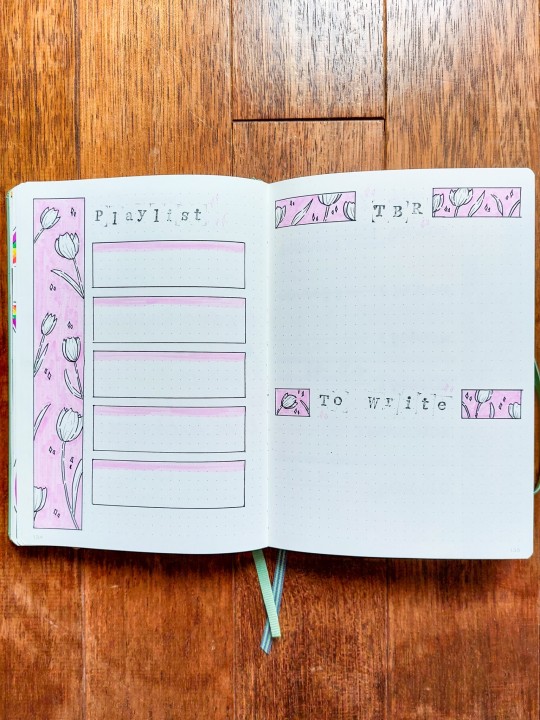


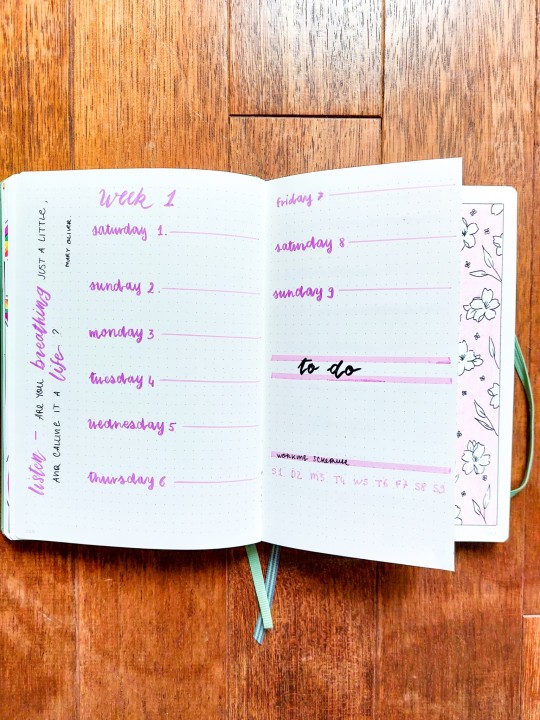
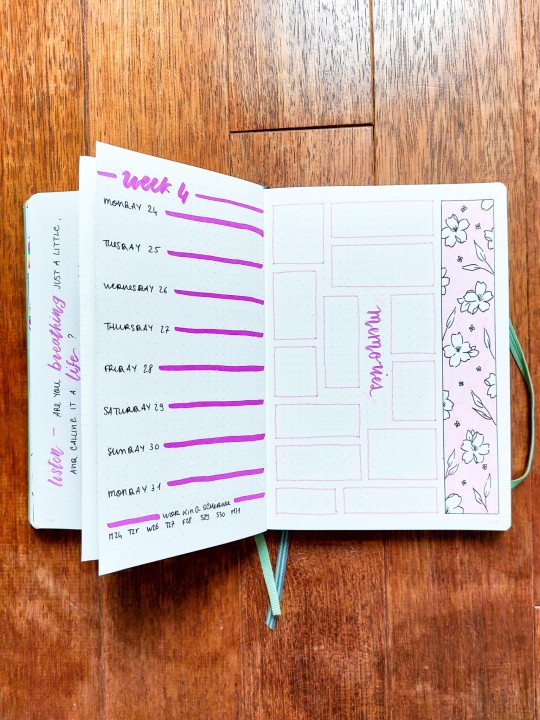
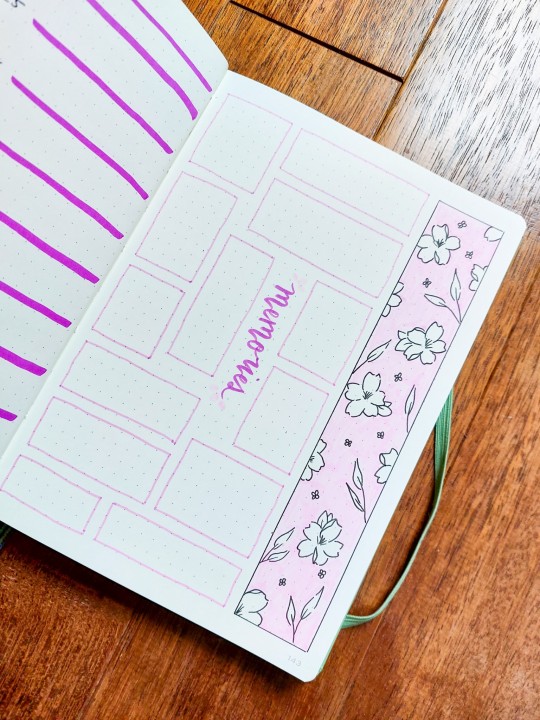
The rest of my bujo spreads for July!
69 notes
·
View notes
Text

New journal :)
#bullet journal community#bullet journal#journal#notebook#new notebook#studyblr#bujo#bujogram#bujo community#bujoblr#bujoinspiration#my bujo
13 notes
·
View notes
Text

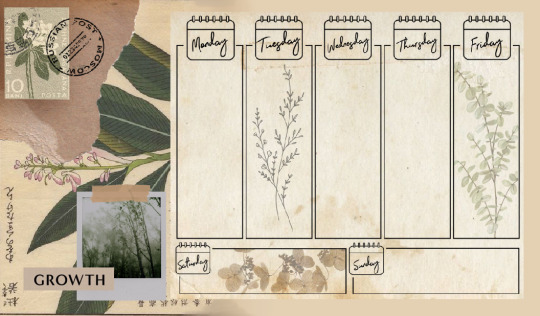





More weekly planners!!! Yeehaw!!
#bujoblr#bujoinspiration#bujo#bujocommunity#bujogram#bujoweeklylayout#bujoweeklyspread#weekly#moodboard#aesthetic#light academia#fairycore#cottagecore#digital#digital collage#collage
91 notes
·
View notes
Text


I made some weekly planners! They're unnumbered if you'd like to use them! and if printed they should fit into an A5 notebook (i believe)
#weekly spread#weekly planner#weekly bujo#digital bujo#bujo#bujo community#bujolife#my bujo#bujospo#bujo spread#digital art#digital collage#digitaldesign#digital bullet journal#light academia#romantic academia#academia#light academia aesthetic
73 notes
·
View notes
Text

Tried out a (mostly) digital collage for my Modern American Poetry class! I’m diggin it so far :)
#procreate#web weaving#light academia#collage#digital collage#study aesthetic#studyblr#study notes#studygram#poetry
25 notes
·
View notes
Text
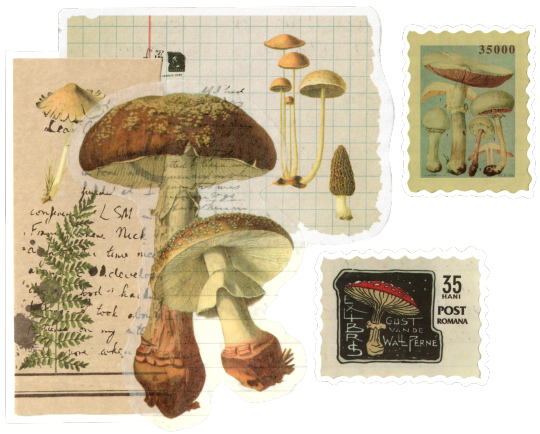
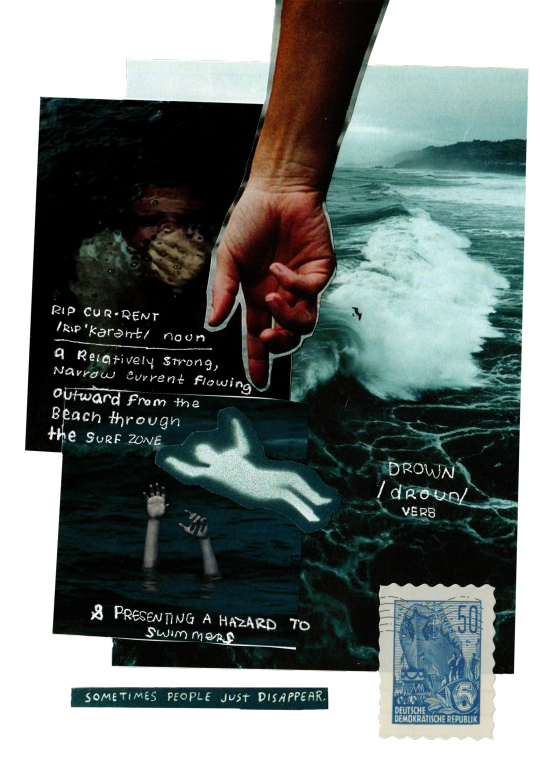
I made some neat collages and slapped em on redbubble. ig some people want to like buy it! It's pretty cool!
Mush 2 Room
Riptide
#collage#mixed media#mixed media art#collage art#abstracart#rip tide#riptide#mushroom art#mushroom#mushrooms#fungi#these images dont inherintly belong to me#if the owner of the images wants me to take these down I will no worries#going forward will be trying to make collages with royalty free images ^^
15 notes
·
View notes
Text

happy 2021 y’all ! Hopefully I will have more time to post this year because I’m dropping out of high school yikes but I’m getting my high school equivalency diploma so those notes will be interesting to say the least !
#studyblr#study aesthetic#notes#bullet journal#study tumblr#study#bullet journal spread#study inspiration#studytumblr#bujo#hello 2021
10 notes
·
View notes
Text


finally got back into bullet journaling after hitting a bit of a slump, I hope you’re all doing well ^^
#studyblr#study aesthetic#notes#bullet journal#study tumblr#study#bullet journal spread#study inspiration#studytumblr#bujo community#bujoblr#bujoideas#bujolife#bujosetup#bujo
9 notes
·
View notes
Text

rough draft of the 69th poem in my collection, probably should’ve made it more romantic in hindsight
8 notes
·
View notes